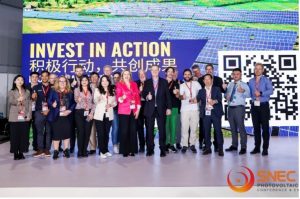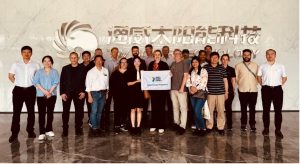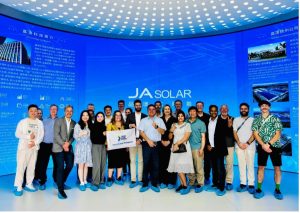What do marathon running and renewable energy prowess have in common? Reflecting on the June 2024 Smart Energy Council Delegation to China and Takeaways for Australia
It was a wake-up call. One I wasn’t expecting. With around 15 trips to China under my belt since 2002, I thought nothing in the Middle Kingdom would surprise me. But I was wrong.
On the Smart Energy Council’s (SEC) June 2024 delegation to China, SEC CEO John Grimes told us that ‘we are all competing in the renewable energy marathon race; it is just that China started an hour or so earlier’. As an avid runner, I know there is no chance of catching the leader with that kind of lead.
My wake-up call was that Australia can be a superpower athlete in the renewable energy marathon, but we will need to partner with the world’s strongest athletes to do it. This includes China. Pragmatic partnerships in our national interest are the only way forward for Australia. Three key elements of China’s renewable energy scene reinforced this for me. 1. Advanced manufacturing. 2. R&D. 3. Scale.
Before I go into these, in two lines, what happened? I joined 22 Australian renewable energy leaders touring five cities (Yangzhou, Hefei, Zhangjiagang, Yancheng and Shanghai), visiting NIO, Tesla, Tongwei Solar, SunGrow, GuofuHee Hydrogen and JA Solar factories. We then attended the Shanghai New Energy PV POWER and Energy Storage EXPO (the largest conference in the world with 600,000 attendees). Ok, so buckle up because this readout summarises my experience of going from 0-100km/h on all things China renewable energy in 2.7 seconds – just like NIO’s latest EV.

- Advanced Manufacturing
It was ‘Future Meets Now’ observing advanced robotics in China. Touring these facilities (no recording allowed) felt like the scene of a sci-fi film. Automatic gripping robotic arms bigger than my living room, fed by intelligent conveying robots and lasers with precision-cutting abilities. It was a privilege to see the Tesla factory just outside of Shanghai, but robotics, automation and battery technology at Chinese EV maker NIO took the prize for me.
NIO offers battery swaps (yes, swaps, not just recharges) in under three minutes in more than 2,500 battery swap stations across China. When we visited NIO House, the company had swapped more than 46,022,131 batteries to date, allowing drivers to upgrade to a battery with a 900-100 kilometre range. Eighty per cent of NIO owners in China have a battery swap and charging facility within three kilometres of their home. Producing a new car every minute, NIO’s advanced robotics and efficiency allows consumers to choose from 3.5 million EV combinations on the NIO app – with a delivery time of within two weeks.

2. R&D
R&D is vital to fuel this technological advancement, especially corporate R&D. CATL, the world’s largest lithium-ion battery producer, spends over USD 2.5bn a year on R&D with a dedicated R&D team numbering 20,604. This has led to the development of its rapid charging system (Shenxing PLUS can deliver a 600-kilometre range in just 10 minutes of charging). CATL recently shared its progress on developing condensed batteries for electric airplanes (a 4-ton electric plane has already taken off using this battery). It plans to develop batteries for 8.8-ton aircrafts that can fly over 2,000 km.
Another R&D example is in the solar space. TW Solar told us they invested USD 568m in 2023 in their Chengdu plant, researching the application of perovskites instead of silicon for solar panels. They are also setting up a pilot HJT (heterojunction) production facility, leveraging advanced photovoltaic technology to reimagine how we power solar cells. Chinese Government and industry alike (and often in partnership) are investing heavily in the renewable energy sector.

3. Scale
I have observed mega operations before, but Chinese renewable energy factories are operating at a scale I was not expecting. JA Solar is on track for 95GW production of solar panels this year. That’s right – one company in one year alone is tripling Australia’s installed solar capacity over our history. At TW Solar, the world’s first PV company listed on the Fortune 500, we learnt that it had 50 per cent of the world’s market share for solar polysilicon and was on track for 130GW production for this year.
At GUOFUHEE Hydrogen, the proud spokeswoman outlined USD 2bn in construction for a hydrogen production facility in Shandong and told us they were already piloting hydrogen-fuelled trucks. The company has set up 61 hydrogen refuelling stations in China (Australia currently has two; I toured the Canberra Hydrogen Refuelling Facility as part of an excellent Australia China Business Council site visit last year). While the economics of hydrogen-fuelled trucks don’t quite stack up just yet, it is clear that China is investing heavily in hydrogen-powered transport and logistics (not just long haul).

What now? Partnerships & People
1. Advanced Manufacturing. 2. R&D. 3. Scale. These are my three big impressions touring China’s renewable energy facilities. So what’s next, and what does this mean for Australia? As many have argued, Australia will thrive if we develop strong international decarbonisation partnerships guided by our national security framework. This includes with China. It is in our national interest to do so.
Australia has much to gain and much to give. Our research and innovation are world-leading (let’s not forget that Professor Martin Green invented the PERC solar cell, which today powers almost 3/4 of all solar panels in the world). And as Oliver Yates (inaugural Clean Energy Financial Corporation Chief) told the delegation, ‘if we play our cards right, we could demonstrate decarbonisation for the globe’, and ‘then consult and invest globally having done it… the very part of this we can compete in’.
But we also have a lot to learn from China’s advanced manufacturing and technological innovation. As Tim Buckley (Director, Climate Energy Finance) likes to remind me, China leads in almost every renewable energy technology. The Future Made in Australia agenda (AUD $22.7 billion over the next decade) provides an important opportunity to get the platform right for working with the world’s leaders in renewable energy, including China. Miss this opportunity, and we won’t even be in the marathon race.
I cannot conclude without mentioning the people. First, the Chinese people. Even accounting for the companies’ putting their most devoted employees forward, it was clear to us that the Chinese workers were proud of being part of the renewable energy story. They took pride in their work, and there was energy in the meeting rooms and factory floors alike. Chinese leaders were proud of their advancements and knew they were leading the race – they had a confidence, but not arrogance, that was infectious. Accompanying this was a pride to showcase their work and collaborate with international partners.

And now to the Australian people. A highlight for me was learning from the ambitious and talented leaders on the delegation. A conversation on the bus back from the Tesla factory with Tim Buckley, Daniel Bleakley, Eddie Greco and Rob Ogilvie about the future of AI, IP, telecommunications, robotics and logistics remains the most fascinating discussion I have had in a long time. It was also special to probe the intersection of politics and energy with SEC International Ambassador and former QLD Premier Annastacia Palaszczuk on high-speed train trips (368km/hr!). I heard some of the most innovative solutions to pressing tech, finance and renewable energy in lively discussions between Robbie Coleman and Oliver Yates. Too many great conversations and people to list – but let me reiterate that I have learnt a lot from this esteemed group.

I am also excited by the prospect of the Australia China Business Council, through our Green Channel program, working with the Smart Energy Council in the lead-up to their Australia China Clean Energy Summit in April next year in Sydney. I admire the energy, talent and commitment of the SEC Team, especially Annastacia Palaszczuk, John Grimes, Wayne Smith, Stephanie Bashir, Joanna Kay, Steve Blume, Elvira Pan and Yuan Fang. The SEC delegation was first-class, and the learning opportunity was invaluable at this formative stage of my professional development and ACBC NSW’s renewable energy work. I also greatly value the generous support of my Executive Committee at ACBC NSW, especially my boss, friend and mentor Helen Zhi Dent.
I am excited to lace up my running shoes again with this talented group to keep Australia working in partnership with China. This is the best way to ensure we are a strong athlete in the renewable energy marathon.
Patrick Mayoh July 2024
Patrick Mayoh is the Australia China Business Council CEO (NSW). Prior to this, he spent a decade in the Australian foreign service, much of this time working on the China portfolio. He also worked at Harvard’s Belfer Center for Science & International Affairs as a Kennedy Fellow (two-year program), advising the first female Deputy Secretary of State, Ambassador Wendy Sherman, on China’s ability to shape geopolitical developments on the Korean Peninsula. He speaks fluent Mandarin and is based in Sydney.
